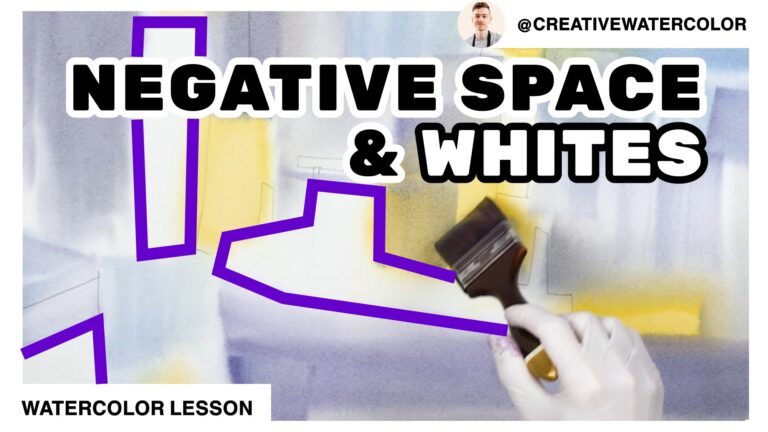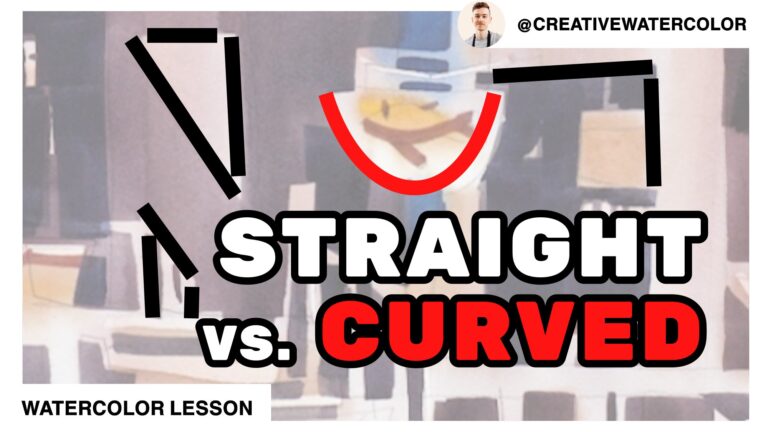Easy way to start your watercolors – seaside town demo 1 of 3. In this easy tutorial you’ll learn the best way to start your watercolor paintings!
Hello everybody, welcome to my studio!
Today’s painting is based on a scene from Port Grimaud – a lovely seaside town in south of France. Let’s paint this wonderful town together!
Let’s first get some fresh paint on the palette. These are my paints:
- Winsor & Newton Winsor Yellow
- Winsor & Newton Winsor Yellow Deep
- Winsor & Newton Permanent Alizarin Crimson
- Winsor & Newton Permanent Rose
- Daniel Smith Pyrrol Red
- American Journey Halloween Orange
- Holbein Permanent Violet
- Winsor & Newton Winsor Blue Green Shade
- American Journey Cerulean Blue
- American Journey Cobalt Blue
- American Journey Joe’s Green (Phthalo green)
And my brushes:
- Winsor & Newton 1/2” Sable One Stroke
- Winsor & Newton 1” Synthetic Series 995
- Robert Simmons 1½” Synthetic White Sable Series
- Robert Simmons 2” Synthetic SkyFlow Series
As you can see, today I’m using only a handful of brushes.
I paint on Arches 140 lb. Rough watercolor paper.
In today’s lesson I demonstrate an easy way to start a watercolor painting. Throughout the years I learned that breaking down the painting process into a set of clear steps can be a great help.
In this video you’ll learn how I start my painting and you’ll see that you too can do this easily!
I keep my reference photo and my value study (which I prepared beforehand) at hand so that I can easily reference them if need be. Today I follow just a few simple steps:
1. I refill my palette with fresh paint.
2. I transfer my drawing onto the watercolor paper.
3. I paint my first wash wet in wet.
1. Fresh paint
Whether I paint every day or skip a few days, I always refill my palette before every painting session. If you want to avoid muddy, weak washes you need fresh tube paint.
2. Drawing transfer
I use a 4 by 4 grid which I draw over my design study. I draw the same grid on my watercolor paper. This helps me properly transfer my shapes onto the paper. I don’t want to accidentally redesign my painting at this stage.
My creativity has been at work while making the value study – but here I want to simply copy my shapes.
3. First wash
Now we’re coming to the main lesson: the first wash.
During the first wash there’s so much room for freedom and fun! Working wet in wet is very forgiving: color can be changed, paint can be lifted or altered altogether.
I start with wetting the front side of my paper with clear water. I let it soak in but while the paper is still damp I start painting.
I remember that during my first wash, the wet in wet underpainting, I only have two simple tasks:
1. I want to paint around my whites.
2. I want to establish my color scheme.
I run a damp brush over the wet paper to pick up any pooling water so that the paper surface is uniformly wet.
Managing your whites
It is crucial to manage your whites in watercolor – in other words, you don’t want to lose your whites. Whites give watercolor that sparkle and you don’t want to loose them. Even if you paint over them, while the paper’s still wet, you can easily pick them up with a “thirsty” (slightly damp) brush.
Establishing color
Getting down your color scheme so early helps you focus on the big picture. That means that this first wash allows you much more freedom in focusing on color and considering your color dominance.
Balance your warm and cool colors and add some neutral mixtures as well. For example paint most of the painting with warm colors (warm dominance), add some cool color accents for contrast and add also some neutrals as visual relief.
Reclaim your whites
The wonderful thing about painting wet in wet is that you can easily fix your mistakes!
If you happen to paint over your whites, you can easily pick up the undesirable paint with a “thirsty” (slightly damp) brush and reclaim your lost whites.
To sum up, remember to focus on two simple tasks when working on your wet in wet underpainting:
1. Paint around your whites
2. Make sure to have your painting either predominantly warm or cool. It’s that easy. Give it a try!
Tip on drying
Before drying off the paper make sure to clean up any water that’s trapped around the edges of the paper.
This’ll prevent the formation of blossoms and blooms.
That’s it for today. I hope you enjoyed the video.
In the next video I’m going to show you how to develop the painting further with layering!
If you have ANY questions, suggestions, comments, leave them below the video, I read every single comment and I’ll get back to you!




